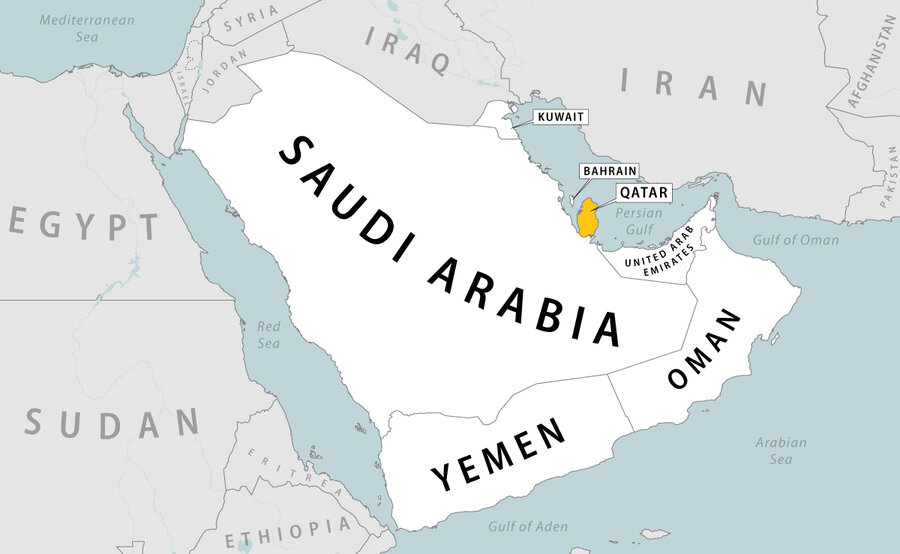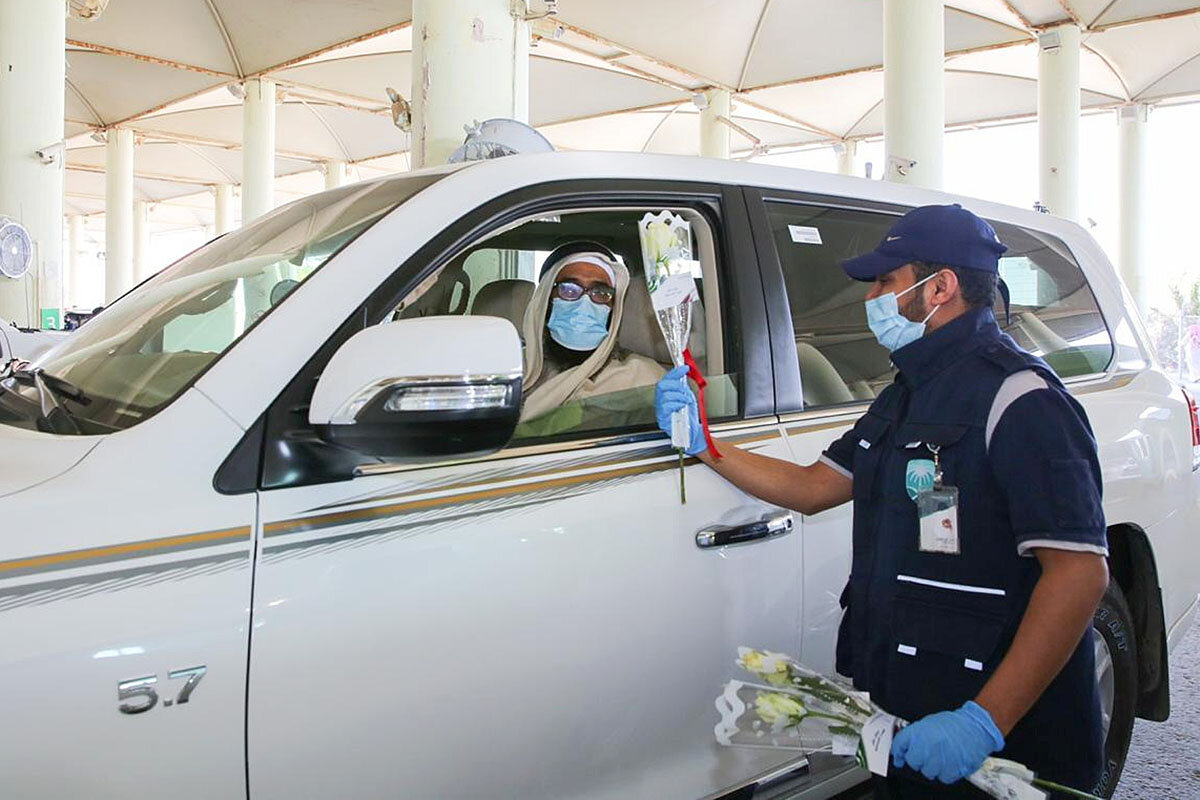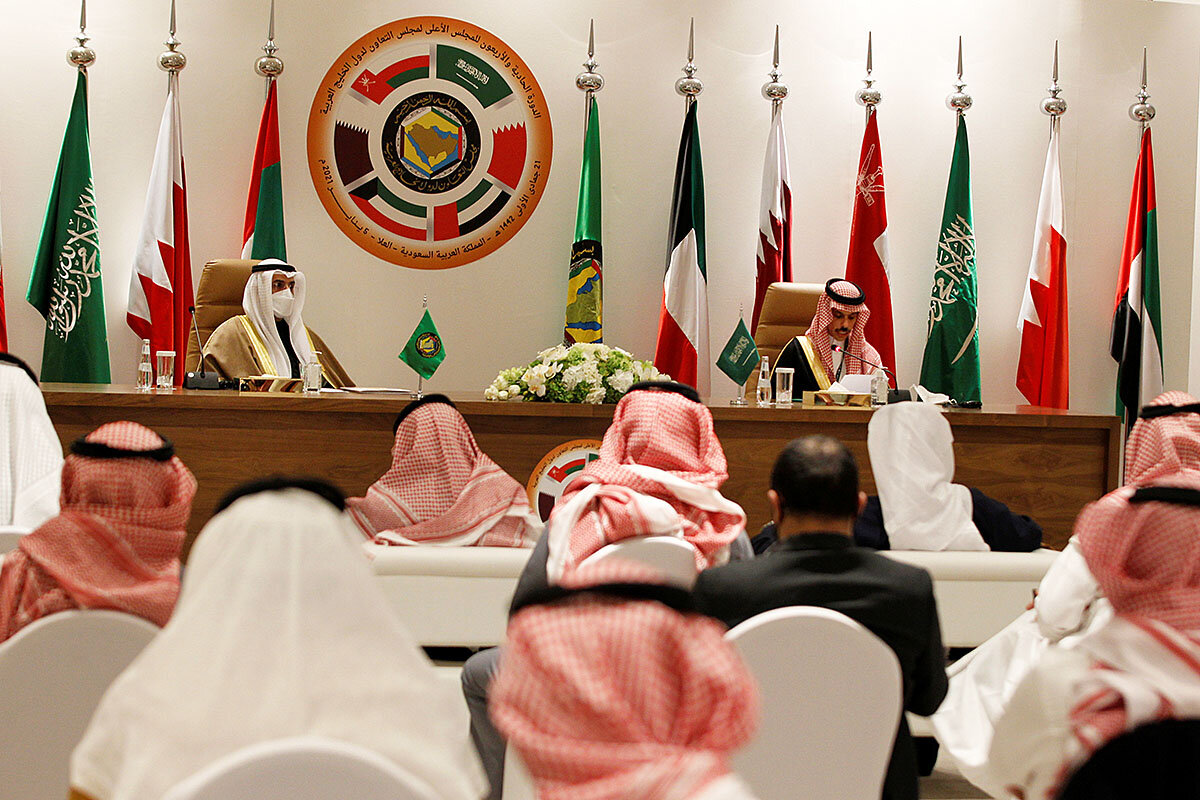End of yearslong Saudi-Qatar feud reunites families, and a region
Loading...
| Amman, Jordan
Feuding royals hugging, music videos celebrating “brotherhood” on national television – the pomp and ceremony of Saudi Arabia and Qatar’s reconciliation, which ended a blockade that divided the Arab world, was as schmaltzy as it was momentous.
In 2017, Saudi Arabia and the United Arab Emirates initiated a blockade against Persian Gulf neighbor Qatar for its support for Islamist movements during the Arab Spring, the influence of its oft-critical Al Jazeera network, and its perceived closeness to Iran.
Travel to and from Qatar was banned, the country’s only land border was blocked, and Qatari flights were barred from Gulf airspace. Riyadh and Abu Dhabi even threatened to instigate a coup, forcing Qatar to build a new alliance with Turkey.
Why We Wrote This
What price political principles? When the Saudis punished Qatar for its policies, it came at a personal and economic cost for residents of the whole region. Reconciliation and cooperation are now in the offing.
Now, 3 1/2 years after a fracture that did little more than divide citizens and hurt economies, Gulf Arab reconciliation is ushering in a renewed appreciation for, and reliance on, regional cooperation.
While observers debate how much the Gulf Cooperation Council (GCC) reconciliation pact signed last week at a summit in Al Ula, Saudi Arabia, was pure PR, Gulf citizens who were told by state media for years to turn against each other have been instantly reconnected.
Overnight, borders reopened and flights resumed.
Family reunions
There was a sense of palpable joy from divided families and friends in a tribal region that is perhaps more connected by blood and trade than any other regional bloc.
Gulf media were full of stories of daughters reunited with their parents, grandparents meeting their grandchildren for the first time.
“The most affected party from the blockade were the people of the GCC, and those who will most feel the benefits of this blockade ending are GCC citizens,” says Najah Al Otaibi, a London-based Saudi analyst.
Single tribes stretch from the tip of Oman up to Kuwait, and families woven by decades of intermarriage among citizens of Qatar, Saudi Arabia, and the UAE were suddenly divided when Riyadh and Abu Dhabi imposed the 2017 blockade.
The renewed appreciation for cooperation even extends to the much-maligned Gulf Cooperation Council.
“When the GCC came to life four decades ago, it made travel easy, it helped to reconnect these families and tribes divided by the borders of the nation-state,” says Abdullah Baabood, an Omani analyst and visiting professor at Waseda University.
“These connections don’t suddenly go away in a blockade or political divisions. This reconciliation is a return to normal.”
Confronting the pandemic
Another area impacted by the deal, brokered in part by Jared Kushner as the Trump administration wound up its Mideast diplomacy, is public health.
In their reconciliation announcement, Gulf leaders established the Gulf Center for Disease Prevention and Control to coordinate efforts in combating COVID-19 and potential future pandemics.
Aside from a much-publicized Zoom call of all Gulf health ministers in March 2020, insiders and observers say there had been minimal coronavirus coordination among Gulf states.
This is despite that, within the Arab world, the Gulf has been hit especially hard. Its combined population of 55 million people has recorded 1 million cases and 10,000 deaths.
The center, in coordination with Gulf health ministries, will assist in vaccine rollout, information-sharing, and research concerning COVID-19 and other infectious diseases.
“This reconciliation agreement injects hope into the idea of regional economic integration and cooperation,” says Giorgio Cafiero of Gulf State Analytics, a Washington, D.C.-based consulting firm, cautioning that political divisions nevertheless remain. “We can see some positive and significant changes in the struggle against COVID-19.”
Economic integration
The GCC’s reconciliation declaration also called for the activation of the much-delayed common Gulf market and a customs union to set uniform trade policy, tariffs, and a single point of entry for Gulf imports.
Observers and citizens say even the most basic steps toward economic integration would alleviate pressures on oil-reliant Gulf states desperate to diversify and privatize their state-run economies amid a pandemic.
One year on from the crash in oil prices, oil only last week reached the $50 per barrel mark and remains well below $60, the fiscal break-even point for every Gulf state save for Qatar.
Gulf states are all looking for ways to keep businesses afloat while facing budget deficits of 12%-20% of gross domestic product one year after paying out a combined $97 billion in bailouts to private sector and semiprivate sector businesses in 2020.
“The impact of the pandemic was positive in the sense that Gulf states realized that the Gulf is stronger when they are united, and they have to be united as we are all facing a common challenge,” says Dr. Otaibi, the Saudi analyst.
Another boost by the rapprochement is in the realm of sports and entertainment.
With Qatar set to host soccer’s World Cup in 2022, the end of the blockade will not only allow for easier logistics for teams and fans to reach Doha, but also let other Gulf states to entice visitors to see the sights in their countries.
Lingering divisions
But questions remain whether greater cooperation and shared economic and health threats can paper over ideological divisions. Observers caution that deep-seated differences remain between Qatar, Saudi Arabia, and the UAE despite the televised hugs.
Crucially, the reconciliation agreement did not address Doha’s support for Islamist movements in the region, which the UAE views as a threat to its own stability and was a stated reason for the 2017 blockade.
Nor did the agreement address Qatar’s alliance with Turkey and its deepening economic reliance on Iran – both partnerships it strengthened due to the blockade.
Meanwhile, Oman and Kuwait do not share Saudi Arabia’s view of Iran as an imminent threat to be neutralized, but rather as a neighbor with whom Gulf states must normalize peaceful ties.
Other observers say such differences make the Al Ula pact’s goals of a “joint defense agreement” and “military integration” unrealistic, for now.
“You can’t move to the final stage of political unity when you don’t have economic unity or a common market,” says Mr. Baabood, the Omani analyst.
“The whole idea of regional integration is that you work on a lower level, build confidence and trust, and work higher to the political level. I am cautiously optimistic now that due to the crises of COVID-19 and oil prices we will start to see serious, concrete action.”
Healing bruised feelings
Hopes are high the deal will cool the polarization fueled by state-run media, talking heads, and social media influencers, all of which were used by governments to attack one another and peddle conspiracy theories.
Previously, UAE-backed media personalities called for the overthrow of the Qatari emir and accused Doha of terrorism, while Qatari networks denounced the UAE as waging a war on democracy, and promoted rumors of Saudi royal family feuds, murder plots, and insurrections.
As the deal was signed, Gulf satellite networks suddenly broadcasted music videos of Gulf citizens singing together and holding hands. Saudi state networks brought on analysts citing the need for Gulf diplomacy and “brotherly” ties with Qatar. Qatar’s Al Jazeera played travel agency, posting clips hailing the beauty of Abu Dhabi , Riyadh, and Al Ula.
Although Gulf media are now falling in line with the decisions of princes and kings, observers question when and if the vitriol and fevered nationalism fed to their publics the past four years will dissipate.
“Governments of these countries can sign an agreement, but that doesn’t mean the Qataris are going to forget what happened to them, or the public forget what was said in the media on a daily basis,” says Mr. Cafiero, of Gulf State Analytics.
“You cannot go 100 miles per hour in one direction, press a button, and suddenly be back where you started.”
“Injuries have occurred on both sides and there are bruises,” Mr. Baabood says. “But over time these bruises will heal.”









